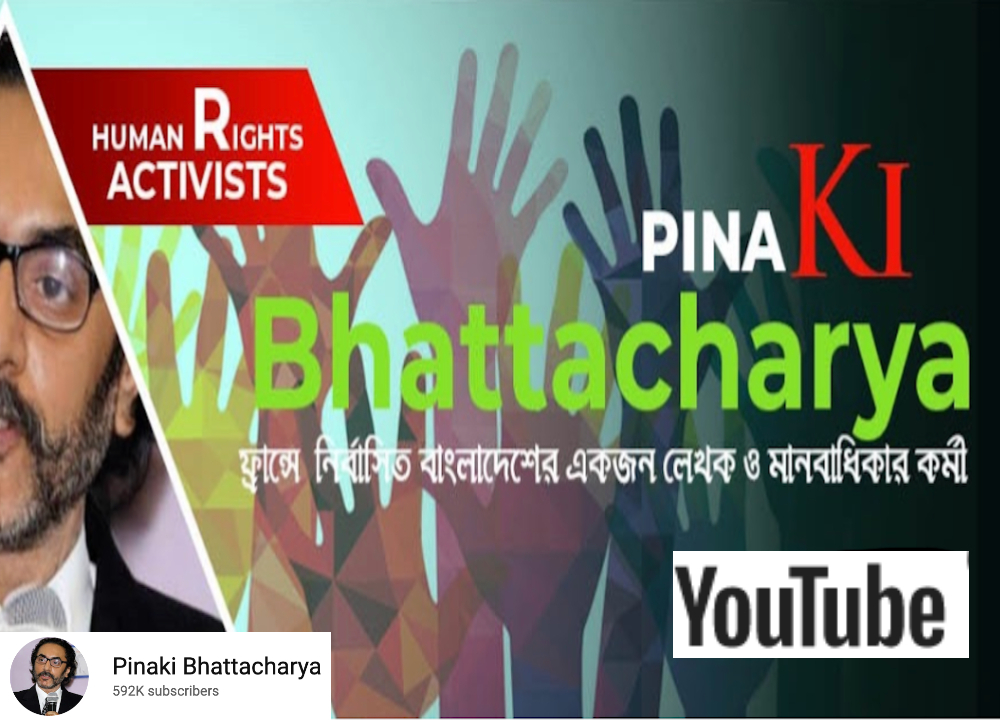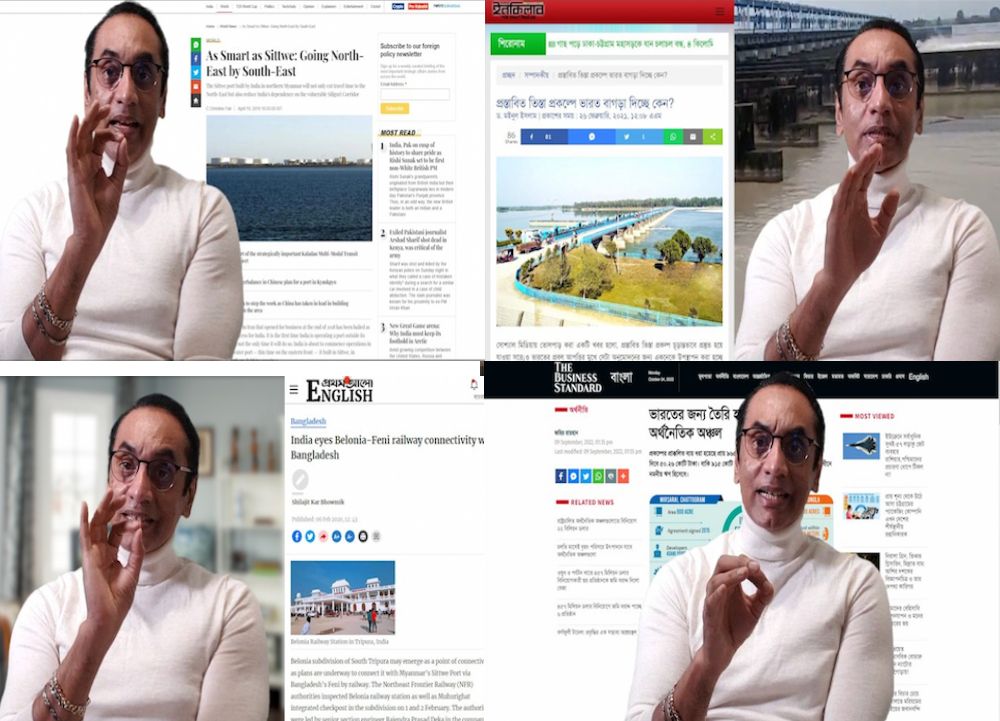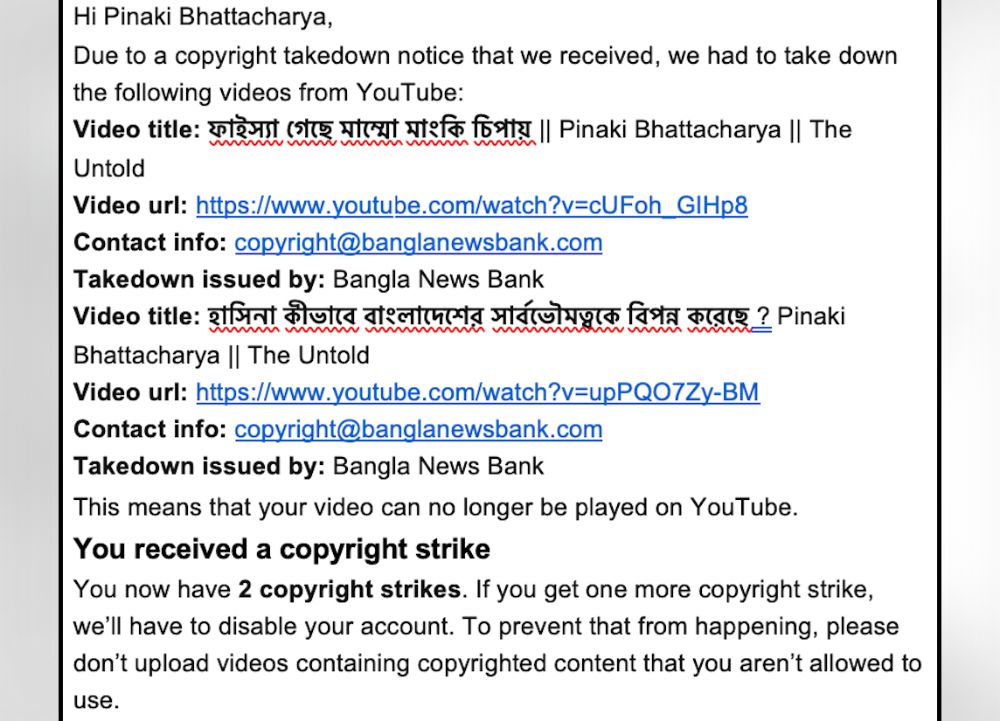Attempt to close YouTube channel of Bangladeshi dissident in France part of ongoing conspiracy to break US law
Action needed to stop widespread breaking of US law, as Bangladesh authorities seek to censor dissidents outside Bangladesh.

The Bangladesh government has a problem, one common to many authoritarian governments. While they can easily control dissent from within their own country, it is more difficult to do so when it is coming from outside.
Though it remains easy for the Bangladeshi authorities to block criticism from abroad when it is published on a website — as they can simply stop it being accessed from inside the country — it is not so straightforward when the content is posted from one of the large social media platforms like YouTube or Facebook.
This is because, technically, it is not possible for the government to block a single YouTube or Facebook account or URL. The only way it can remove specific accounts is to block the whole social media platform – and because of the huge popularity of these social media websites, this is not politically feasible.
It is this conundrum that has led to the government to propose introducing new laws and policies that will require social media platforms to act as political censors. However, it remains unclear whether social media platforms will be willing to become, in effect, censors for an authoritarian state.
So until the day comes when social media companies are willing to subordinate themselves in this way, the country’s authoritarian agencies have two techniques which they deploy to silence critics abroad.
The first is the use of repression — that is, the arrest, intimidation, or harassment of the Bangladesh-based family members of the person who is responsible for publishing the content abroad. Note for example the the harassment of Tasneem Khalil’s mother [editor-in-chief of Netra News] and Pinaki Bhattacharya's family, and the arrest and seven month detention of Kanak Sarwar’s sister.
The government’s other strategy is — using intelligence agencies or ruling party contractors — to make fake copyright claims to internet service providers or social media platforms requiring them to remove content and close websites or YouTube channels set up by expatriate Bangladeshis.
DMCA 2008
You may ask why platforms like YouTube would act on fake copyright claims. The answer to that is the requirement of the US law, the Digital Millennium Copyright Act 1988 (DMCA 2008), which Bangladesh authorities have found a way to exploit and turn against itself.
This DMCA 2008 has a legitimate purpose. It seeks to balance the needs of two key parties. On the one hand there are copyright holders who have a legitimate expectation that their copyrighted material is not copied and used illegitimately by others; and, on the other hand, there are internet providers or social media platforms, who do not want to be held liable for copyrighted material which is published by others on websites or channels which they host. Under the DMCA 2008, companies are protected from potential liability for what their users post, but only if they agree to introduce a “notice and takedown” scheme.
The notice and takedown scheme works like this. A person or organisation who owns the copyright to content (a video, an article, an image etc.) can, when they find it posted on someone else’s website or social media page, send a takedown notice to the relevant internet provider or platform asking it to remove the infringing content.
The internet provider or social media platform is then required to take down the material, while, at the same time informing the website or social media user (which had illegally uploaded the copyrighted material) of their right, if they feel that the material has been removed in error, to file a counter notice asking that the material be reposted. When a counter notice is sent, the copyright holder can initiate legal action against the person who is infringing their copyright, but if that does not happen, the service provider/platform will repost the material back on the site/page within 14 days.
Although this law only applies to US companies, the copyright notice and takedown scheme has become a default standard among much of the commercial internet in other countries.
So how do the Bangladesh government authorities misuse this legislation, so material produced by legitimate copyright holders gets removed — the exact opposite of the intention of the law? They do this by doing the following:
— identifying the content on a YouTube channel or website which they want removed;
— copying this original content onto a website which the government authorities/contractors control;
— sending a takedown request to the relevant internet service provider or social media platform claiming that the material that they have copied onto their own site is in fact the original copyrighted material and demand that the material on YouTube/website be taken down.
— The internet service provider or social media platform will automatically act on this request removing the original content, mistakenly assuming that it is infringing copyright.
As Netra News has reported on numerous occasions - here, here, here and here. Indeed Netra News itself has been subject to it. This has, as one can see, become a very common and effective technique.
What is particularly remarkable about this is how those who make the takedown requests using DCMA are the people who are actually violating copyright law, and should be the ones subject to the law.
But this technique does not only result in getting content removed. YouTube for example has a policy that if it receives three takedown notices, it will close the channel. And internet service providers will also have similar kinds of policies about taking offending websites offline. As a result, fake copyright claims can have devastating impact on YouTubers and website owners producing critical commentary on Bangladesh.
Pinaki Bhattacharya
A new takedown attempt has taken place in the last week involving the YouTube channel of Pinaki Bhattacharya. Pinaki is a doctor and social media activist, who was forced to leave Bangladesh in 2018 and is now living in France having received refugee status. A year ago he started up a YouTube channel which has in recent months become very popular with each daily video getting on average 500,000 views, and has in total 69 million views.
On October 26th, YouTube contacted Pinaki and informed him that it had received a takedown request from a website called Bangla News Bank. This website claimed that one of its own videos titled “How has Hasina endangered the sovereignty of Bangladesh” posted on its site in February 2018 had been illegally posted by Pinaki on his YouTube Channel. In line with the DMCA 2008, YouTube automatically removed the video from Pinaki’s channel.
This though is what - actually - happened.
Pinaki made the video and posted it on his YouTube channel on October 25th 2022 (the day before he received the takedown notice). Bangla News Bank – a pro-Awami League website most likely run by government agencies or party subcontractors – posted the video on to its own website, and sent a takedown notice to YouTube which automatically removed the Pinaki’s original video.
It was clear that the video could not have been posted in February 2018, as claimed by Bangla News Bank, since it refers to issues that happened in 2022 and contains images of press cuttings dated afterwards: December 6th 2018, April 19th 2019, February 6th 2020, September 26th 2021 and September 9th 2022.

On the following day, October 27th 2022, Pinaki received another takedown notice relating to another video, “Mommy got trapped” which he had posted on April 22nd 2022 concerning the prime minister’s difficulties in deciding whether to back China or the USA. This was also removed.

It would take just one more takedown notice and his channel would be closed.
Pinaki sent counter notices for both videos, but so anxious was he that a third takedown notice was imminent, he instructed a lawyer to contact YouTube.
“My client legitimately fears, after two unfounded warnings in two days, to receive a third notification and have his channel banned,” his lawyer Charles Morel wrote, appending a detailed note on the circumstances of the fake copyright claims. “You therefore understand the urgency of preventing this very serious attack on freedom of expression.”
This seems to have worked and a day later YouTube reposted the videos.
The conspiracy
It is a crime to make false representations under the DMCA 2008 and so each time a fake takedown request is made, a criminal offence is being committed. What this means is that those who are organising this strategy, which is used very widely against Bangladeshi dissidents living abroad, are involved in a widespread conspiracy to break US law.
This is something the US government and YouTube should act upon, not only to protect the free speech of critics and dissidents living outside Bangladesh but to ensure that its own laws are upheld and not misused.●